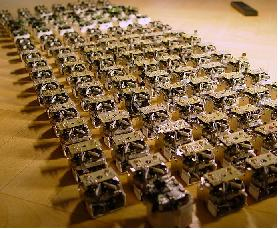Industry Trends: Swarm Robotics
February 7, 2012
Other more recent forays into swarm intelligence have produced highly effective search algorithms, often imitating the behavior of bees and ants, among other results. Since swarm intelligence is highly parallel by nature, the field has seen a boom with the relatively recent advances in multi-core and many-core computing. The most recent advances in the field are actually in robotics due to the advances of compact, low-power computing devices. Researchers at the Swiss Federal Institute of Technology have developed a swarm of quadrocopters that built a tower out of foam blocks autonomously. More recently researchers at the University of Pennsylvania have been able to fly similar quadrocopters in formations. Finally, there is a concerted effort in the UK to develop modular robots that can rearrange themselves to better perform the task at hand.
I foresee some of the most advanced technology coming out of the public’s fascination with robots, and the research community’s trending toward parallel-computing solutions. I will personally be keeping my eye on advances in this field, if only to prevent swarms of evil, self-replicating modular robots from taking over the galaxy.